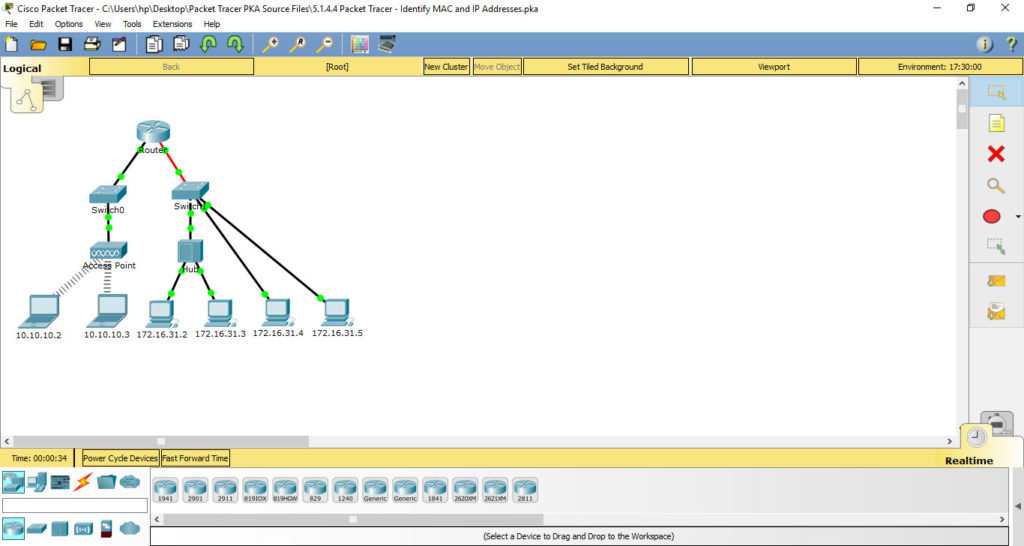Packet Tracer – Identify MAC and IP Addresses

Objectives
Part 1: Gather PDU Information
Part 2: Reflection Questions
Background
This activity is optimized for viewing PDUs. The devices are already configured. You will gather PDU information in simulation mode and answer a series of questions about the data you collect.
Part 1: Gather PDU Information
Note: Review the Reflection Questions in Part 2 before proceeding with Part 1. It will give you an idea of the types of information you will need to gather.
Step 1: Gather PDU information as a packet travels from 172.16.31.2 to 10.10.10.3.
a. Click 172.16.31.2 and open the Command Prompt.
b. Enter the ping 10.10.10.3 command.
c. Switch to simulation mode and repeat the ping 10.10.10.3 command. A PDU appears next to 172.16.31.2.
d. Click the PDU and note the following information from the Outbound PDU Layer tab:
· Destination MAC Address: 00D0:BA8E:741A
· Source MAC Address: 000C:85CC:1DA7
· Source IP Address: 172.16.31.2
· Destination IP Address: 10.10.10.3
· At Device: Computer
e. Click Capture / Forward to move the PDU to the next device. Gather the same information from Step 1d. Repeat this process until the PDU reaches its destination. Record the PDU information you gathered into a spreadsheet using a format like the table shown below:
Example Spreadsheet Format

Step 2: Gather additional PDU information from other pings.
Repeat the process in Step 1 and gather the information for the following tests:
· Ping 10.10.10.2 from 10.10.10.3.
· Ping 172.16.31.2 from 172.16.31.3.
· Ping 172.16.31.4 from 172.16.31.5.
· Ping 172.16.31.4 from 10.10.10.2.
· Ping 172.16.31.3 from 10.10.10.2.
Part 2: Reflection Questions
Answer the following questions regarding the captured data:
1. Were there different types of wires used to connect devices?
2. Did the wires change the handling of the PDU in any way?
3. Did the Hub lose any of the information given to it?
4. What does the Hub do with MAC addresses and IP addresses?
5. Did the wireless Access Point do anything with the information given to it?
6. Was any MAC or IP address lost during the wireless transfer?
7. What was the highest OSI layer that the Hub and Access Point used?
8. Did the Hub or Access Point ever replicate a PDU that was rejected with a red “X”
9. When examining the PDU Details tab, which MAC address appeared first, the source or the destination?Why would the MAC addresses appear in this order?Was there a pattern to the MAC addressing in the simulation?
10. Did the switches ever replicate a PDU that was rejected with a red “X”?
11. Every time that the PDU was sent between the 10 network and the 172 network, there was a point where the MAC addresses suddenly changed. Where did that occur?Which device uses MAC addresses starting with 00D0?
12. To what devices did the other MAC addresses belong?
13. Did the sending and receiving IPv4 addresses switch in any of the PDUs?
14. If you follow the reply to a ping, sometimes called a pong, do the sending and receiving IPv4 addresses switch?
15. What is the pattern to the IPv4 addressing in this simulation?Why do different IP networks need to be assigned to different ports of a router?
16. If this simulation was configured with IPv6 instead of IPv4, what would be different?
Suggested Scoring Rubric
There are 20 questions worth 5 points each for a possible score of 100.
